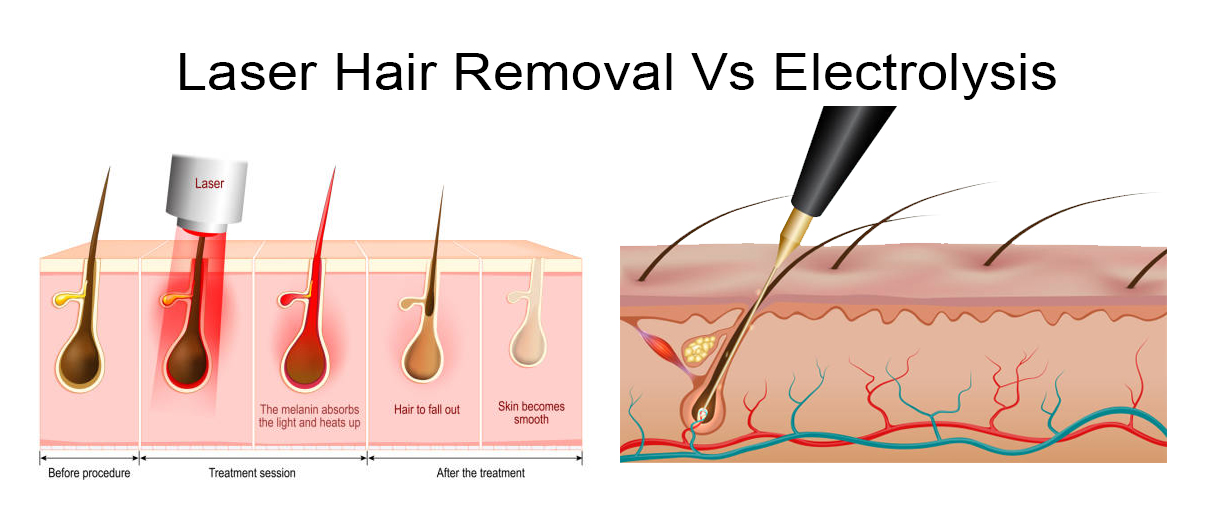
Electrolysis vs Laser Hair Removal: Choosing the Right Method for Lasting Hair Removal
Introduction
For those seeking to attain silky, hair-free skin, there are multiple hair removal techniques, each with its benefits and factors to consider. Two prominent contenders stand out among these methods: electrolysis and laser hair removal. These techniques offer more permanent solutions than temporary methods like waxing and shaving. In this article, we’ll delve into the details of electrolysis and laser hair removal, shedding light on their processes, suitability for different individuals, pros and cons, and what to expect from each method. By understanding the key aspects of these methods, you can make an informed decision on the best approach to achieve your desired results.
Definition of Electrolysis and Laser Hair Removal
Electrolysis and laser hair removal are both methods to provide more permanent solutions for unwanted hair growth. Electrolysis involves the insertion of a fine probe into individual hair follicles, followed by applying an electrical current to destroy the follicle’s ability to grow hair. In contrast, laser hair removal employs focused light beams to target and damage the melanin in hair follicles, thereby preventing future hair growth. Both methods are designed to offer longer-lasting results compared to temporary hair removal techniques.
Book Your Free Consultation Today Or Call (647) 560-9233
By providing your phone number you agree to receive informational text messages from laserskin.ca. Consent is not a condition of purchase. Message frequency will vary. Msg & data rates may apply. Reply HELP for help or STOP to cancel.
Brief History of Both Methods
Electrolysis has a longer history, dating back to the late 19th century when it was introduced as a method for permanent hair removal. On the other hand, laser hair removal gained prominence in the late 20th century, with advancements in laser technology allowing for more effective and efficient treatments. Both methods have evolved, with technological innovations enhancing their safety, effectiveness, and accessibility.

Understanding Electrolysis
The Process of Electrolysis
In electrolysis, a fine probe is inserted into each hair follicle. An electrical current is then applied through the probe to destroy the follicle’s ability to grow hair. The process involves a chemical reaction that weakens the hair follicle and impedes future hair growth. Multiple sessions are required to target all hair follicles in the treated area.
Who is a Suitable Candidate for Electrolysis?
Electrolysis is a flexible method that works well for people of all skin and hair types, particularly those with light hair colours like blonde or white, who might not get optimal results from laser hair removal due to insufficient pigment in the hair.
Pros and Cons of Electrolysis
Pros:
- Appropriate for every skin tone and hair type.
- Permanent hair removal method.
- It can be used on small, delicate areas (e.g., eyebrows, upper lip).
- Precise targeting of individual hair follicles.
Cons:
- Time-consuming due to treating individual follicles.
- Some people may experience mild skin redness and irritation.
- Typically, it requires multiple sessions for desired results.
- Potential discomfort during the procedure.
What to Expect from an Electrolysis Session
During an electrolysis session, a practitioner inserts a fine probe into individual hair follicles. An electrical current is then applied to destroy the follicle’s ability to grow hair. The feeling is commonly likened to a minor sting or pinprick. After the session, mild redness and swelling might occur, which usually subsides within a few hours. Following the recommended aftercare instructions is essential for minimizing any potential side effects.
Understanding Laser Hair Removal
The Process of Laser Hair Removal
Laser hair removal utilizes concentrated beams of light (laser) absorbed by the hair’s pigment (melanin). This energy from the light is changed into heat, disrupting the hair follicles and obstructing subsequent hair regrowth. Multiple treatment sessions are required to target hair follicles in their active growth phase.
Who is a Suitable Candidate for Laser Hair Removal?
The efficacy of laser hair removal is heightened for individuals with dark hair and lighter skin, as the contrast improves the efficiency of the treatment. That said, newer laser technologies have expanded the range to include individuals with darker complexions.


Pros and Cons of Laser Hair Removal
Pros:
- Effective for large areas of the body.
- Fewer sessions are required compared to electrolysis.
- Precise targeting of hair follicles without affecting the surrounding skin.
- Minimal recovery time and side effects.
Cons:
- It may be less effective for individuals with light hair colours.
- Possible temporary side effects like redness and swelling.
- Risk of skin colour changes, especially for individuals with darker skin tones.
- It may require maintenance sessions to address future hair growth.
What to Expect from a Laser Hair Removal Session
During a laser hair removal session, a trained practitioner uses a handheld device to deliver laser beams to the treated area. The sensation is often likened to a rubber band snapping against the skin. After the session, there may be mild redness and sensitivity, which typically subside within a day or two. Following proper aftercare guidelines can minimize any potential side effects.
Comparison between Electrolysis and Laser Hair Removal
As you weigh the options between electrolysis and laser hair removal, examining the factors contributing to each method’s efficacy, time efficiency, and patient comfort level is crucial. Both methods offer more permanent hair removal solutions than temporary techniques, but their mechanisms and suitability vary. Let’s delve into a detailed comparison to help you make an informed decision.
Efficiency and Effectiveness
Electrolysis and laser hair removal target hair follicles to inhibit future hair growth. However, electrolysis is often considered more precise due to its ability to treat individual hair follicles. It’s an effective choice for small, delicate areas like the eyebrows and upper lip. Conversely, laser hair removal employs focused light beams to address more extensive areas, which speeds up the treatment process for places like the legs and back. The effectiveness of each method can vary based on factors such as skin tone, hair colour, and hormonal changes.
Pain and Discomfort during the Processes
Pain and discomfort levels during electrolysis and laser hair removal can differ among individuals. Electrolysis involves inserting a fine probe into each hair follicle, which may cause slight discomfort and a pricking sensation. The experience of laser hair removal is often equated to the quick flick of a rubber band hitting the skin. Both methods are generally well-tolerated, and the sensation is brief. However, individual pain thresholds can influence the overall experience.
Cost Analysis: Electrolysis vs. Laser Hair Removal
Cost is a significant consideration when choosing a hair removal method. Electrolysis is typically priced based on the time spent during each session, and costs can add up as multiple sessions are required. Laser hair removal costs vary based on the size of the treated area and the number of sessions needed. While electrolysis may seem more expensive due to its time-intensive nature, laser hair removal can incur costs for larger areas and multiple sessions.
Skin and Hair Types Suitable for Each Method
Electrolysis is a versatile method effective for all skin and hair types, including those with light or white hair that might not be well-suited for laser treatment. Laser hair removal works optimally on people with light skin and dark hair, but recent technological improvements have also expanded its applicability to those with darker skin tones.
Electrolysis Hair Removal Cost
|
INDIVIDUAL SESSIONS |
PACKAGE DEALS |
||||
|
30 MIN |
60 MIN |
90 MIN |
SAVE 10% |
SAVE 15% |
SAVE 25% |
|
ONE 30 MIN SESSION |
ONE 60 MIN SESSSION |
ONE 90 MIN SESSION |
3 X ONE HOUR SESSIONS |
5 X ONE HOUR SESSIONS |
8 X ONE HOUR SESSIONS |
|
$80 |
$140 |
$200 |
$378.00 |
$595.00 |
$840.00 |
|
|
|
|
Save $42 |
Save $105 |
Save $280 |
Potential Side Effects and Risks
Both methods have potential side effects, although generally minor and temporary. After electrolysis, individuals may experience redness, swelling, and skin sensitivity, which usually subside within a few hours. Laser hair removal may cause temporary redness, itching, and a slight burning sensation. Skin type, sensitivity, and aftercare practices can influence both methods’ occurrence and severity of side effects.
Choosing the Right Method for You
Assessing Your Hair Removal Needs
Before making a decision, assessing your hair removal needs is crucial. Consider the treatment area, your hair and skin type, and whether you seek localized treatment or address larger areas. Electrolysis is suitable for precision and targeting small areas, while laser hair removal is efficient for larger body areas.
Consultation with a Specialist
Speaking with a board-certified dermatologist or a licensed medical professional is crucial for identifying the best hair removal method for your situation. Professionals can evaluate your skin and hair characteristics, discuss your expectations, and recommend the method that aligns with your goals.
Personal Experience and Preference
Personal experience and preference play a role in the decision-making process. Some individuals may prefer the precision of electrolysis for specific areas, while others may prioritize the efficiency of laser hair removal for larger treatment areas. Your comfort level with the sensations and potential side effects can also influence your choice.
Q&A
Is there a difference in the effectiveness of electrolysis and laser hair removal on various body areas?
Electrolysis and laser hair removal can effectively affect various body areas. Electrolysis is highly precise and can target small areas effectively, while laser hair removal is better suited for larger treatment areas such as legs, arms, back, and face.
Can people with blonde hair and fair skin benefit from laser hair removal?
People with blonde hair and fair skin can benefit from laser hair removal. However, they may require more sessions due to the lower contrast between hair and skin colours, which affects the effectiveness of the treatment.
What role does the FDA play in regulating laser hair removal treatments?
The FDA (Food and Drug Administration) regulates medical devices, including laser hair removal devices. It ensures that these devices are safe and effective for use and provides guidelines for their use by practitioners.
Are there fewer side effects associated with laser hair removal than other methods?
Laser hair removal typically has fewer side effects than traditional methods like waxing or shaving. However, some temporary side effects may include redness, swelling, and slight discomfort, which usually subside shortly after the treatment.
Which is the only permanent hair removal method approved by the FDA?
Electrolysis is the only permanent hair removal method approved by the FDA. An electric current impairs the hair follicle, preventing future hair growth.
What factors influence the rate of hair regrowth after laser hair removal?
The rate of hair regrowth after laser hair removal can be influenced by factors such as hormonal changes, individual hair growth cycles, and the area of the body being treated.
How does the blood supply affect the efficacy of laser hair removal?
The blood supply to the hair follicles can impact the efficacy of laser hair removal. Follicles with a strong blood supply may recover and regrow hair more quickly after treatment.
Is laser therapy considered a more permanent solution for hair removal?
Laser therapy, specifically laser hair removal, is considered a more permanent solution for hair removal. It significantly reduces hair growth and provides long-lasting results.
What is galvanic electrolysis, and how does it work to achieve long-term hair removal?
Galvanic electrolysis is a method of electrolysis that uses direct electric currents to destroy hair follicles chemically. The method functions by triggering a chemical reaction within the hair follicle, inhibiting new hair growth.
Can laser hair removal treatments be performed on people with darker skin tones?
Yes, laser hair removal can be performed on people with darker skin tones. However, it requires specialized equipment and expertise to avoid potential side effects such as changes in skin colour. Consulting with a certified professional is crucial for deciding the most effective treatment for individuals with darker skin tones.
How does electrolysis hair removal compare to laser treatments in terms of effectiveness on different body areas?
Electrolysis hair removal is effective on all body areas, including smaller and more delicate regions like the eyebrows and upper lip. While effective in larger areas, laser treatments may have limitations in smaller and more sensitive areas.
Who are considered good candidates for hair removal treatments, and how can patients determine the better option for them?
Good candidates for hair removal treatments include individuals with different hair types, skin colours, and hair growth patterns. Patients seeking better results often consult with professionals who assess their needs and recommend laser treatments or electrolysis based on factors such as hair type, skin colour, and the affected areas.
Conclusion
In conclusion, choosing between electrolysis and laser hair removal depends on various factors, including hair and skin characteristics, treatment goals, and pain tolerance. Both methods offer effective ways to achieve more permanent results in hair removal. Electrolysis offers high accuracy, making it ideal for targeting small regions and adaptable to different hair and skin types. Conversely, laser hair removal is quicker for treating extensive areas and works optimally on individuals with dark hair and lighter skin. Consulting with experts, evaluating your specific requirements, and comprehending the pros and cons of each technique will help you make an informed decision for more enduring hair removal outcomes.
Electrolysis Toronto Clinic
Book Your Free Consultation Today Or Call (647) 560-9233
By providing your phone number you agree to receive informational text messages from laserskin.ca. Consent is not a condition of purchase. Message frequency will vary. Msg & data rates may apply. Reply HELP for help or STOP to cancel.

